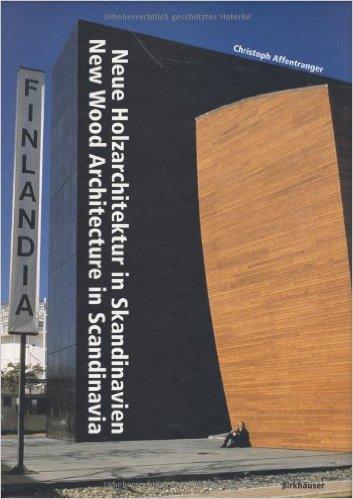
Graphic design: Miriam Bussmann/Karin Weisener
A book from the German publisher Birkhäuser, New Wood Architecture in Scandinavia provides a comprehensive overview of the use of timber in construction throughout the five Scandinavian countries. While the book was published almost twenty years ago, it heavily focuses on the history of timber use and, thus, the perspective that it offers has not been supplanted by the intervening years. Christopher Affentrager has a commanding expertise in this field, and his book is extremely well constructed.
New Wood Architecture is comprised of an introduction and five sections, one each for the Scandinavian countries of Denmark, Finland, Iceland, Norway and Sweden. The sections contain case studies on various projects from those countries that showcase timber usage that Affentranger believes to be of note. Each section is prefaced by a short essay that goes into the details of timber within the context of Scandinavia, providing a wealth of information on the history, techniques and design philosophies that are inherent to wood in those northern countries.
The first essay examines the current state of wood use in Scandinavian architecture, going into the two different poles on the spectrum of tradition vs. high technology. This general overview precedes the section on Denmark, which is one of the two smallest sections, containing only two buildings. The reason for this is fairly evident once pointed out; Denmark is a country that no longer has many trees on it, and so their building traditions have tended more towards brick since the end of the 18th century.
The second essay looks at the mystical history of wood as a part of Scandinavia and how it has interacted with the countries on a cultural level. As a material with such a long history of use, dating all the way back to the beginnings of human history in the area, there is a powerful cultural significance to timber as a structural form. The second of the countries to be examined is Finland, which has a much larger history of wood use than Denmark and, thus, has triple the inclusions in New Wood Architecture than Denmark. These case studies range from the extremely simple constructions such as the summer home in Ararat “At the End of the World” (68), a weekend house built by a coalition of farmers, to the larger public commissions as in the Finish Forestry Museum (76), to even the art project of The Birth of Light (92), a tiny room in the middle of the forest that questions the meaning of space.
The subject of the third essay is the different ways in which wood has been joined in the Scandinavian countries, going from the various historical methods to the modern techniques. The following country, Iceland, is similarly to Denmark, a country in which timber constructions might not be thought to have been typical of its history, but there are a number of interesting examples, particularly due to the historical contacts with Norway and Denmark and the transport of large quantities of wood to Iceland since the 9th century.
The fourth essay is on the different ways that the Scandinavian countries have reacted to the modern industrialisation of the timber industry and created their own particular styles and traditions. Norway is the country of origin for the case studies that follow the essay, and is particularly important to the context of timber design in the Scandinavian countries due to the influence that it has had on the others, particularly Iceland and Denmark, through the Viking sailors that originated from it. One of the projects that is included in this section is thus particularly appropriate — the stadium built for the XVII Olympic Winter Games, shaped in the form of an upturned Viking longboat (142). This building, in addition to its unique shape, was at the time of its construction the widest glued-beam roof in the world. Another project that calls directly to the history of Norway is the Sami Region Centre (168), located above the polar circle.
The final essay looks at the conflicts between architectural movements, specifically modernism and regionalism. This particular debate has been on-going for many years, but the comparatively-recent development of engineered wood products and the corresponding changes in building code regulations has seen it become even more relevant. The inclusions in Sweden’s section are residential, with three being single-family residences and only one a multi-family residence.
The case studies from the five sections are not the only buildings that are mentioned in New Wood Architecture; there are 71 other building that are alluded to or mentioned briefly. As such, Affentranger includes a very brief explanation of each of these buildings at the end of the book, touching on the major points of the project.
New Wood Architecture in Scandinavia provides an in-depth view of timber construction throughout the Scandinavian countries in the later years of the twentieth century, a highly influential period when it comes to the modern era and the proliferation of engineered wood and mass timber.
